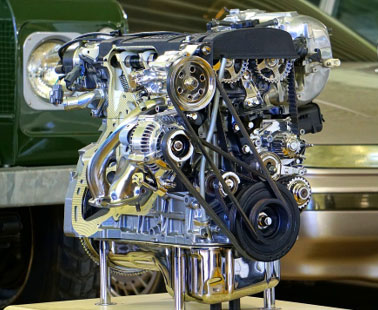Precision Metal Shims in Automobile Engineering
The world of automobile engineering is a complex one, filled with intricate components whose design and functionality play a critical role in the overall performance and safety of a vehicle. One such component, often overlooked but nonetheless crucial, is the precision metal shim. These thin pieces of metal are used in various parts of a vehicle, from engines to gearboxes, to achieve the perfect alignment or spacing. Precision metal shims are versatile and are available in an array of materials, shapes, and sizes to cater to different engineering requirements. The use of these shims is not limited to just the automotive industry; they are equally prevalent in sectors like aerospace, construction, manufacturing, and more.
However, in the context of automobile engineering, precision is paramount, making shims vital. The importance of precision cannot be understated in the field of automobile engineering. Every component must be designed and manufactured to near-perfect precision to ensure the vehicle’s efficient operation and longevity. This is where precision metal shims come into play. But, a key attribute of these shims that plays a significant role in their effectiveness is their flatness.
Understanding the Concept of Shim Flatness
Shim flatness refers to the degree of precision with which the surface of a shim, or indeed any material, is made flat. It is a critical specification that ensures the shim will perform optimally in its intended application. In engineering terms, flatness is a condition of a surface wherein all elements are in the same plane. Flatness is not just about the physical appearance of the surface. It also relates to the even distribution of weight and pressure when the shim is in use. A perfectly flat shim ensures an even transfer of load, reducing the risk of component failure. When it comes to precision metal shims, achieving a high degree of flatness is an intricate process that requires advanced manufacturing techniques. The importance of this process cannot be overstated, as the flatness of a shim can greatly influence its effectiveness and the overall performance of the vehicle.
The Importance of Precision Flatness in Shims
Precision flatness in shims is not just a desirable attribute; it is a necessity. Without a high degree of flatness, a shim may not provide the correct spacing or alignment, which could lead to suboptimal performance or even mechanical failure. Precision flatness ensures that the shim provides uniform support, which is crucial in applications such as bearing adjustments, alignment of drive shafts, and gear mesh in transmissions. A lack of flatness can result in uneven load distribution, leading to excessive wear and premature failure of components. Moreover, precision flatness in shims also helps to reduce noise, vibration, and harshness (NVH) in vehicles. By ensuring proper alignment and spacing, shims can minimize the vibrations that occur during vehicle operation, thereby enhancing the comfort and driving experience of the users.
The Role of Automotive Shims in Vehicle Performance
Automotive shims play a variety of roles in enhancing vehicle performance. They are integral to the functioning of various systems within the vehicle, including the engine, transmission, suspension, and braking systems. In the engine, precision metal shims are used to achieve the perfect valve clearance. Proper valve clearance is crucial for the engine to operate efficiently and prevent issues such as power loss, increased fuel consumption, and premature wear of components. In the transmission system, shims are used to align the gears correctly. Precision flatness in these shims ensures that the gears mesh correctly, thereby reducing wear and tear and improving the longevity of the transmission system. In the suspension and braking systems, shims are used to align and space various components. They help to reduce friction, minimize noise and vibrations, and enhance the overall performance and safety of the vehicle.
Impacts of Inaccurate Shim Flatness on Automobile Engineering
Inaccurate shim flatness can have significant adverse effects on automobile engineering. It can lead to misalignment of components, uneven load distribution, and increased wear and tear, all of which can negatively impact the vehicle’s performance and safety. Misalignment of components due to inaccurate shim flatness can cause a variety of issues. For instance, in the engine, incorrect valve clearance can lead to decreased engine efficiency, increased fuel consumption, and even potential engine damage. Uneven load distribution is another major concern. Without precision flatness, the load is not distributed evenly across the shim, leading to uneven wear and tear. This can cause premature failure of components and potentially result in costly repairs. Increased wear and tear due to inaccurate shim flatness can significantly reduce the lifespan of the vehicle’s components. This not only leads to increased maintenance costs but can also pose safety risks if the wear and tear lead to mechanical failure while the vehicle is in operation.
Techniques to Achieve Precision Flatness in Metal Shims Achieving precision flatness in metal shims is a complex process that requires advanced manufacturing techniques. There are several methods used in the industry to achieve this level of precision, including grinding, lapping, and precision machining. Grinding is a process that involves removing material from the surface of the shim to achieve the desired flatness. This is typically done using a grinding wheel, which is composed of abrasive grains that cut away at the material. Lapping is another method used to achieve precision flatness. This process involves rubbing the shim against a flat lap or lapping plate with a fine abrasive slurry in between. The rubbing action grinds down high spots on the shim, resulting in a flat surface. Precision machining, on the other hand, involves using advanced computer-controlled machines to cut and shape the shim to the desired specifications. This method offers a high degree of accuracy and allows for the production of shims with complex shapes and patterns.
The Real-world Application of Precision Flatness
To better understand the importance of precision flatness in automotive shims, let’s consider a real-world case study. A major automobile manufacturer was facing issues with their transmission system. The gears were not meshing properly, leading to increased wear and tear and reduced efficiency. Upon investigation, it was discovered that the issue stemmed from inaccurate shim flatness. The shims being used in the transmission system were not flat enough, leading to misalignment of the gears. The solution was to replace the existing shims with precision flat shims. These new shims, manufactured using advanced grinding techniques, provided the perfect alignment for the gears. The result was a significant improvement in the transmission system’s efficiency and longevity, demonstrating the critical role that precision flatness plays in automotive shims.
How to Choose the Right Automotive Shim for Precision Flatness
Choosing the right automotive shim for precision flatness is crucial to ensure optimal vehicle performance. There are several factors to consider when selecting a shim, including the type of material, the thickness of the shim, and the manufacturing process used. The type of material is important as different metals have different properties. For example, stainless steel shims are known for their durability and resistance to corrosion, making them a good choice for applications where the shim will be exposed to harsh conditions. The thickness of the shim is another crucial consideration. The thickness should be chosen based on the specific application and the degree of adjustment required. The manufacturing process used to produce the shim can also influence its flatness. Shims manufactured using advanced techniques like grinding, lapping, or precision machining are likely to have a higher degree of flatness compared to those produced using traditional methods.
Future Trends in Shim Flatness for Automobile Engineering
The field of automobile engineering is constantly evolving, and the importance of shim flatness is only set to increase in the future. As vehicles become more advanced, the demand for precision in every component will continue to rise. One trend to watch is the use of advanced materials in shim manufacturing. Materials like high-strength steel and composites offer superior properties compared to traditional metals, and their use could lead to shims with even greater precision and flatness. Another trend is the use of digital manufacturing techniques. Digital technologies like Computer Numerical Control (CNC) machining and 3D printing offer a high degree of precision and allow for the manufacture of complex shim designs. This could pave the way for more efficient and effective shims in the future.
Shim Flatness in Automobile Engineering
In conclusion, the importance of shim flatness in automobile engineering is undeniable. From ensuring the proper alignment of components to reducing noise and vibrations, precision flat shims play a crucial role in enhancing vehicle performance and safety. As the industry continues to evolve, the demand for precision and flatness in automotive shims is set to increase. By understanding the importance of this attribute and how to achieve it, automobile engineers can ensure that they are using the best possible components in their designs.
Whether you are an automobile engineer, a mechanic, or just a car enthusiast, understanding the critical role of precision flatness in automotive shims can help you appreciate the complexity and precision that goes into every vehicle’s design and manufacturing. Start exploring precision metal shim, flatness, Precision flatness, automotive shim today and experience the difference they can make in your automobile engineering projects!
Automobile Engineering | Michigan
Northern Industrial Manufacturing is your turnkey partner for even the most challenging projects. Our experts understand which options work best for your specific material and surface finish requirements, and offer the most advanced technologies to meet the needs of your unique project.
We will bring your parts to market on time – with assistance from prototype to volume production – quickly, affordably and efficiently as possible.
Thank you for visiting our blog where we keep customers updated and informed on the latest processes in automotive parts manufacturing!
Please check back often if you would like to learn more about the world of precision thrust washers, selective shims, spacers, and other automotive parts.




